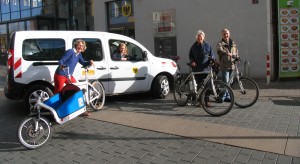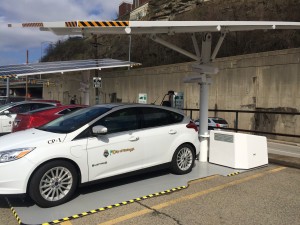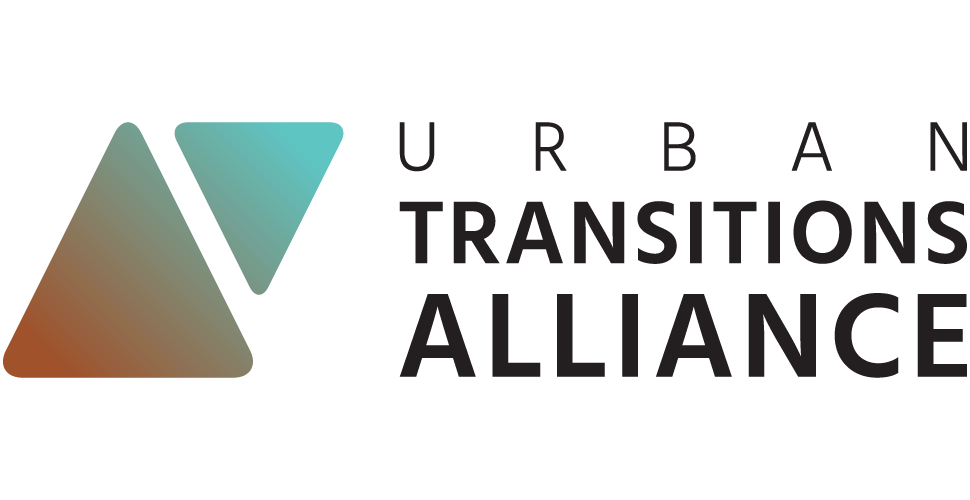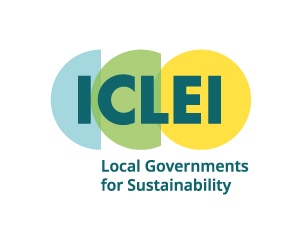THE POTENTIAL OF GREEN FLEETS
How industrial legacy cities are advancing sustainable mobility transitions through green fleet management
By Rebecca Wessinghage, Transition Concepts Officer, ICLEI – Local Governments for Sustainability
This blog post also appeared on CityTalk – A blog by ICLEI on 07 Mar 2019.
Industrial legacy cities often have a history of quick population growth, urban sprawl and single-purpose urban planning. These factors have led to development trajectories that separated industrial districts from residential districts, creating car-centric infrastructure that enabled social, economic, and ethnic segregation. Today, many industrial legacy cities in the Urban Transitions Alliance are working to overcome high car-dependency that contributes to clogged streets and high levels of air pollution. At the same time, logistical requirements of industrial production left behind infrastructure assets like streetcar and railway lines that can be used to cities’ advantage.
Sustainable transport is a key milestone on the path towards cleaner and healthier urban environments, and many cities are seeking to reduce individual motorized traffic as a crucial step towards achieving this goal. There are many factors that influence complex urban mobility systems – from national regulation to individual behavior – but municipal fleets and their operation are among the components directly under the control of the local government. Green fleets are therefore an opportunity for cities to directly influence the sustainability of their transport system. Given the substantial size of city fleets – 3,450 units in Cincinnati and 1,100 vehicles in Pittsburgh – the introduction of cleaner technologies forms an important part of cities’ strategies to reduce emissions and improve air quality.
The potential of green fleet management goes beyond its direct impact; through green fleet strategies cities can spearhead the urban mobility transition. When local governments take action and lead by example, they raise awareness and model sustainable choices. By greening municipal fleets, local governments also support the infrastructure needed to enable more sustainable transport options and pave the way for a broader systemic mobility transition.
DIMENSIONS OF GREEN FLEET MANAGEMENT

Bicycles and cargo bikes as part of the municipal fleet in the City of Dortmund.
In order to understand how green fleet management can impact urban mobility and help to achieve air quality standards and climate goals, we first need to define what it entails. Municipal fleets include components as diverse as light vehicles for administrative staff, police cars, public transport vehicles like busses and streetcars, heavy-duty vehicles like waste and maintenance trucks, ambulances and fire trucks, and sometimes even boats and trailers.
According to Transport for London’s Sustainable fleet management guide, sustainable fleet strategies are based on three key types of measures that enable local governments to reduce both costs and emissions. The first step is the efficient management of transport demand. If trips are assessed for necessity and routes are combined when feasible, the overall amount of miles traveled can be reduced, and likely also the size of fleets. Sharing practices further enhance this effect. The second recommendation concerns fleet composition and vehicle distribution: cleaner technologies and the choice of the smallest, most efficient vehicle for each purpose can reduce emissions significantly. However, the amount of saving also depends on indirect emissions like the energy source for electric vehicles and the production cycle. Thirdly, driving and maintenance practices affect fuel consumption, material wear and repair and replacement cycles. Targeted guidelines and trainings for drivers and technicians help ensure efficient vehicle use.
Cities across the Urban Transitions Alliance have set about greening their municipal fleets through these three types of measures. Many are implementing cleaner technologies; Katowice has recently hit the news by purchasing 300 electric buses, an amount that exceeds the number of electric busses currently in service on Polish streets. Beijing Huairou District already runs 180 electric busses, which make up 83 percent of its total fleet, and Pittsburgh has committed to operate a fossil fuel free fleet by 2030.
In Baltimore, introducing smaller fire trucks such as those used in Europe and Asia could both save fuel and make space on the streets for bike lane installations. Diversified vehicle options go hand in hand with an efficient and integrated management of transport demand. To maximize synergies, US cities in the Alliance have begun operating municipal departments for integrated fleet management services. For example, the Baltimore Fleet Management Division oversees 5,600 pieces of motorized equipment from 29 departments and cooperates with the Municipal Office of Sustainable Energy to reduce fuel consumption. When it comes to promoting sustainable driving and maintenance practices, the City of Dortmund is now requiring all city employees to undertake an eco-driving training for fuel-efficient driving. The program is expected to be cost-effective due to the fuel savings and will be scaled up if it proves to be successful.
HOW GREEN FLEET MANAGEMENT CAN DRIVE MOBILITY TRANSITIONS

Solar charging stations for electric vehicles in the City of Pittsburgh.
What are the elements of green fleet management that cause a larger impact? In terms of cleaner technologies, the electrification of municipal fleets provides an opportunity to install and expand charging infrastructure throughout the city. For example, the Baltimore Parking Authority operates EV chargers in city garages and street-side locations, simultaneously serving local government agencies and the general public. Aiming to maximize its sustainability and resiliency goals, the City of Pittsburgh has taken an additional step towards clean energy sources and recently introduced solar powered charging stations. By investing in sustainable industries and infrastructure, cities contribute to increased supply and technological advancements. In short, sustainable procurement choices help to create a market for cleaner technologies.
The composition of municipal fleets also impacts drivers’ habits and sets an example for the community. Municipalities increasingly rely on smaller vehicle options and also bikes wherever suitable to promote a shift in the modal split. For example, the City of Dortmund has centralized and diversified its municipal mobility management – pooling vehicles of all sizes, including bicycles, and providing recommendations for the most efficient choice / route for each trip. The Ruhr region city of Bottrop has even started to subsidize personal bikes for city staff on the condition that staff cycle for business trips within a certain radius. These measures incentivize city staff to adapt their everyday transport choices while helping municipalities to better understand road users’ needs and improve their mobility strategies.
Having experienced inevitable structural transformations, industrial legacy cities in the Urban Transitions Alliance have chosen to actively steer their transitions by shaping more eco-friendly and barrier-free mobility systems. Acknowledging the great potential of green fleet management, Alliance cities are refining their strategies to simultaneously reduce costs, emissions and road congestion. Denser areas like the German Ruhr Region are increasingly expanding traffic planning to the inter-city and regional level. Yet, the biggest challenge will be to instigate wider behavioral change across the population – a true transformation that must be supported by municipal and national policy.


